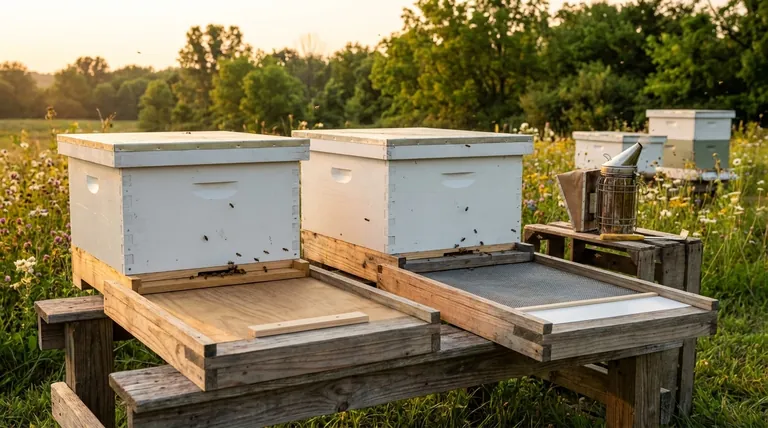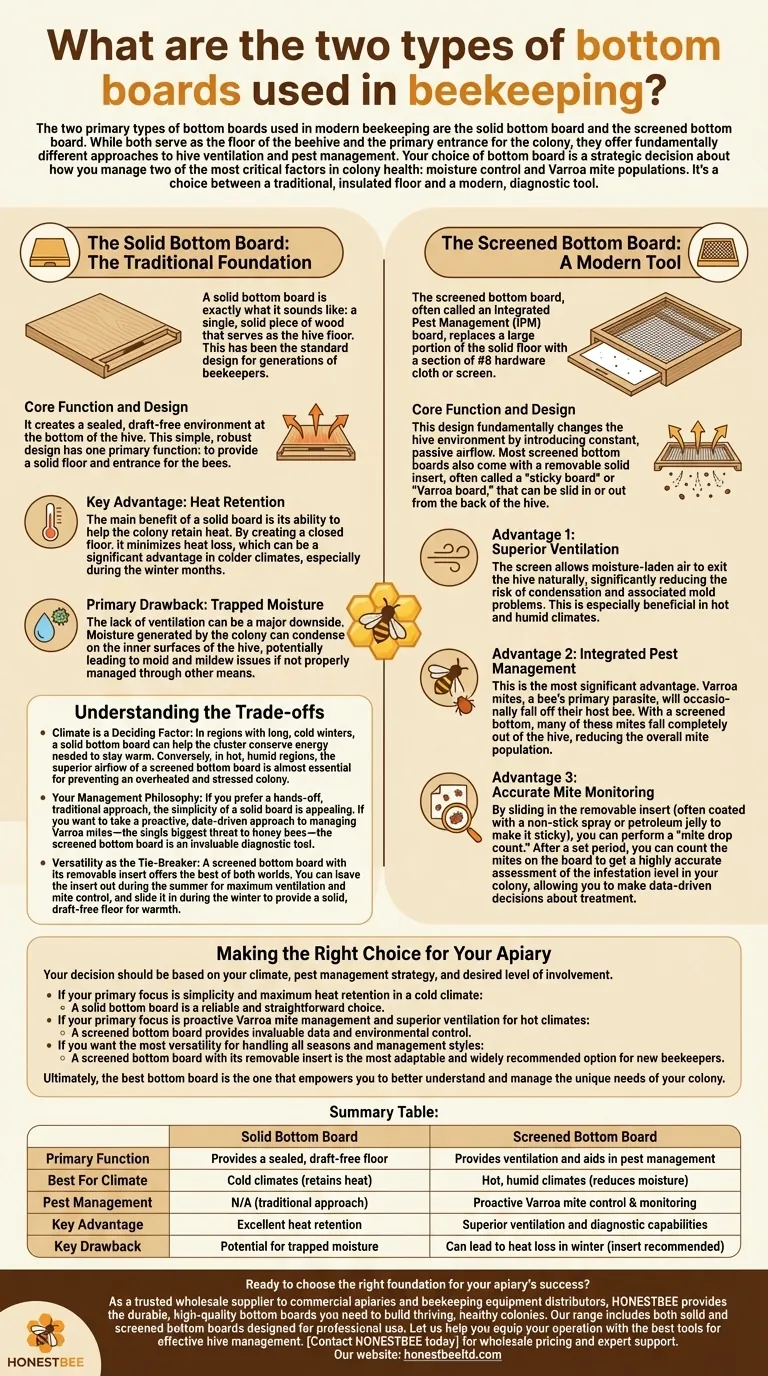The two primary types of bottom boards used in modern beekeeping are the solid bottom board and the screened bottom board. While both serve as the floor of the beehive and the primary entrance for the colony, they offer fundamentally different approaches to hive ventilation and pest management.
Your choice of bottom board is a strategic decision about how you manage two of the most critical factors in colony health: moisture control and Varroa mite populations. It's a choice between a traditional, insulated floor and a modern, diagnostic tool.

The Solid Bottom Board: The Traditional Foundation
A solid bottom board is exactly what it sounds like: a single, solid piece of wood that serves as the hive floor. This has been the standard design for generations of beekeepers.
Core Function and Design
It creates a sealed, draft-free environment at the bottom of the hive. This simple, robust design has one primary function: to provide a solid floor and entrance for the bees.
Key Advantage: Heat Retention
The main benefit of a solid board is its ability to help the colony retain heat. By creating a closed floor, it minimizes heat loss, which can be a significant advantage in colder climates, especially during the winter months.
Primary Drawback: Trapped Moisture
The lack of ventilation can be a major downside. Moisture generated by the colony can condense on the inner surfaces of the hive, potentially leading to mold and mildew issues if not properly managed through other means.
The Screened Bottom Board: A Modern Tool
The screened bottom board, often called an Integrated Pest Management (IPM) board, replaces a large portion of the solid floor with a section of #8 hardware cloth or screen.
Core Function and Design
This design fundamentally changes the hive environment by introducing constant, passive airflow. Most screened bottom boards also come with a removable solid insert, often called a "sticky board" or "Varroa board," that can be slid in or out from the back of the hive.
Advantage 1: Superior Ventilation
The screen allows moisture-laden air to exit the hive naturally, significantly reducing the risk of condensation and associated mold problems. This is especially beneficial in hot and humid climates.
Advantage 2: Integrated Pest Management
This is the most significant advantage. Varroa mites, a bee's primary parasite, will occasionally fall off their host bee. With a screened bottom, many of these mites fall completely out of the hive, reducing the overall mite population.
Advantage 3: Accurate Mite Monitoring
By sliding in the removable insert (often coated with a non-stick spray or petroleum jelly to make it sticky), you can perform a "mite drop count." After a set period, you can count the mites on the board to get a highly accurate assessment of the infestation level in your colony, allowing you to make data-driven decisions about treatment.
Understanding the Trade-offs
Neither bottom board is inherently "better" than the other; they are simply different tools for different goals and environments. Bees can thrive with either type.
Climate is a Deciding Factor
In regions with long, cold winters, a solid bottom board can help the cluster conserve energy needed to stay warm. Conversely, in hot, humid regions, the superior airflow of a screened bottom board is almost essential for preventing an overheated and stressed colony.
Your Management Philosophy
If you prefer a hands-off, traditional approach, the simplicity of a solid board is appealing. If you want to take a proactive, data-driven approach to managing Varroa mites—the single biggest threat to honey bees—the screened bottom board is an invaluable diagnostic tool.
Versatility as the Tie-Breaker
A screened bottom board with its removable insert offers the best of both worlds. You can leave the insert out during the summer for maximum ventilation and mite control, and slide it in during the winter to provide a solid, draft-free floor for warmth.
Making the Right Choice for Your Apiary
Your decision should be based on your climate, pest management strategy, and desired level of involvement.
- If your primary focus is simplicity and maximum heat retention in a cold climate: A solid bottom board is a reliable and straightforward choice.
- If your primary focus is proactive Varroa mite management and superior ventilation for hot climates: A screened bottom board provides invaluable data and environmental control.
- If you want the most versatility for handling all seasons and management styles: A screened bottom board with its removable insert is the most adaptable and widely recommended option for new beekeepers.
Ultimately, the best bottom board is the one that empowers you to better understand and manage the unique needs of your colony.
Summary Table:
| Feature | Solid Bottom Board | Screened Bottom Board |
|---|---|---|
| Primary Function | Provides a sealed, draft-free floor | Provides ventilation and aids in pest management |
| Best For Climate | Cold climates (retains heat) | Hot, humid climates (reduces moisture) |
| Pest Management | N/A (traditional approach) | Proactive Varroa mite control & monitoring |
| Key Advantage | Excellent heat retention | Superior ventilation and diagnostic capabilities |
| Key Drawback | Potential for trapped moisture | Can lead to heat loss in winter (insert recommended) |
Ready to choose the right foundation for your apiary's success?
As a trusted wholesale supplier to commercial apiaries and beekeeping equipment distributors, HONESTBEE provides the durable, high-quality bottom boards you need to build thriving, healthy colonies. Our range includes both solid and screened bottom boards designed for professional use.
Let us help you equip your operation with the best tools for effective hive management.
Contact HONESTBEE today for wholesale pricing and expert support.
Visual Guide

Related Products
- Langstroth Screen Bottom Board for Beekeeping Wholesale
- Australian Pine Wood Langstroth Screen Bottom Board for Wholesale
- HONESTBEE Wooden Bee Escape Board with Triangle Mesh Design for Beekeeping
- HONESTBEE Professional Frame Wiring Board and Jig
- Classic Boardman Entrance Bee Feeder Hive Front Feeding Solution
People Also Ask
- What are some considerations when choosing between solid and screened bottom boards? Optimize Hive Health & Pest Control
- What are the assembly options for the Cypress Screened Bottom Board? Ready-to-Use for Immediate Hive Health
- How should the screened bottom board be used throughout the year? A Guide for Healthy Hives
- How does a screened bottom board assist with temperature control and pest management? A Key Tool for Modern Beekeeping
- What are the advantages of a screened bottom board? Boost Hive Health with Superior Ventilation & Pest Control



















